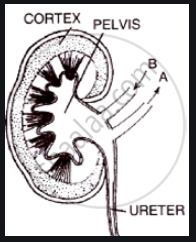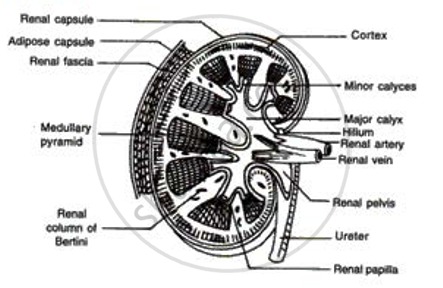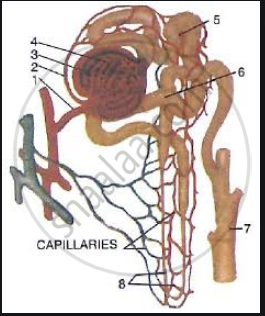Advertisements
Advertisements
Question
Given below is a highly simplified diagram of the human kidney cut open longitudinally. Answer the question that follow:
Write two differences in composition of the blood flowing through the blood vessels, 'A' and 'B'.

Solution
The blood vessel 'B' is renal artery and the blood vessel 'A' is renal vein.
So the blood vessel 'B' contains oxygenated blood with high concentration of urea and glucose whereas the blood vessel 'A' contains deoxygenated blood with low concentration of urea and glucose as compared to renal artery.
APPEARS IN
RELATED QUESTIONS
Fill in the blank.
....................... are present in the stem of pine tree that make the pinewood strong and durable.
In humans, urea is formed in
Name the following:
The tuft of capillaries inside the Bowman's capsule.
Name the following:
The vein in which urea concentration is maximum
Explain the difference between the excretory system of humans and plants.
Choose the correct answer:
Composition of extracellular fluid is regulated by ___________
Given below is a diagram of a human kidney, cut open longitudinally. Answer the following:

(i) Give definition of excretion.
(ii) Name the unit of kidney.
(iii) Why does the cortex of kidney show dotted appearance?
(iv) List the functions of the kidney.
The following diagram represents a mammalian kidney tubule (nephron) and its blood supply.

Parts indicated by the guidelines 1to 8 are as follows:
1. Afferent arteriole from renal artery
2. Efferent arteriole
3. Bowman's capsule
4. Glomerulus
5. Proximal convoluted tubule with blood capillaries
6. Distal convoluted tubule with blood capillaries
7. Collecting tubule
8. U-shaped loop of Henle
Study the diagram and answer the question that follow:
Which structure contains the lowest concentration of urea?
Adult frog is an amphibian, its mode of excretion is ______.
Why is the rate of breathing in aquatic organisms much faster than in terrestrial organisms?
